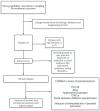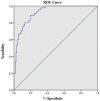Social Media, Thin-Ideal, Body Dissatisfaction and Disordered Eating Attitudes: An Exploratory Analysis
- PMID: 31671857
- PMCID: PMC6861923
- DOI: 10.3390/ijerph16214177
Social Media, Thin-Ideal, Body Dissatisfaction and Disordered Eating Attitudes: An Exploratory Analysis
Abstract
Disordered eating attitudes are rapidly increasing, especially among young women in their twenties. These disordered behaviours result from the interaction of several factors, including beauty ideals. A significant factor is social media, by which the unrealistic beauty ideals are popularized and may lead to these behaviours. The objectives of this study were, first, to determine the relationship between disordered eating behaviours among female university students and sociocultural factors, such as the use of social network sites, beauty ideals, body satisfaction, body image and the body image desired to achieve and, second, to determine whether there is a sensitive relationship between disordered eating attitudes, addiction to social networks, and testosterone levels as a biological factor. The data (N = 168) was obtained using validated surveys (EAT-26, BSQ, CIPE-a, SNSA) and indirect measures of prenatal testosterone. The data was analysed using chi-square, Student's t-test, correlation tests and logistic regression tests. The results showed that disordered eating attitudes were linked to self-esteem (p < 0.001), body image (p < 0.001), body desired to achieve (p < 0.001), the use of social media (p < 0.001) and prenatal testosterone (p < 0.01). The findings presented in this study suggest a relationship between body image, body concerns, body dissatisfaction, and disordered eating attitudes among college women.
Keywords: body image; disordered eating behaviours; female; social media; university students..
Conflict of interest statement
The authors declare no conflict of interest.
Figures
Similar articles
-
The mass media exposure and disordered eating behaviours in Spanish secondary students.Eur Eat Disord Rev. 2010 Sep-Oct;18(5):417-27. doi: 10.1002/erv.1024. Eur Eat Disord Rev. 2010. PMID: 20593479
-
The Impact of Social Media on Disordered Eating: Insights from Israel.Nutrients. 2025 Jan 3;17(1):180. doi: 10.3390/nu17010180. Nutrients. 2025. PMID: 39796614 Free PMC article.
-
Examining an elaborated sociocultural model of disordered eating among college women: the roles of social comparison and body surveillance.Body Image. 2014 Sep;11(4):488-500. doi: 10.1016/j.bodyim.2014.07.012. Epub 2014 Aug 20. Body Image. 2014. PMID: 25160010 Free PMC article.
-
Mapping the pathway to anabolic-androgenic steroids (AAS) use.Compr Psychiatry. 2025 Aug;141:152602. doi: 10.1016/j.comppsych.2025.152602. Epub 2025 May 15. Compr Psychiatry. 2025. PMID: 40382967 Review.
-
Conceptualizing body dissatisfaction in eating disorders within a self-discrepancy framework: a review of evidence.Eat Weight Disord. 2018 Jun;23(3):275-291. doi: 10.1007/s40519-018-0483-4. Epub 2018 Feb 9. Eat Weight Disord. 2018. PMID: 29423688 Review.
Cited by
-
Social media use and body image issues among adolescents in a vulnerable Louisiana community.Front Psychiatry. 2022 Nov 3;13:1001336. doi: 10.3389/fpsyt.2022.1001336. eCollection 2022. Front Psychiatry. 2022. PMID: 36405904 Free PMC article.
-
Gait pattern can alter aesthetic visual impression from a third-person perspective.Sci Rep. 2024 Mar 19;14(1):6602. doi: 10.1038/s41598-024-56318-5. Sci Rep. 2024. PMID: 38503793 Free PMC article.
-
A cross-sectional descriptive analysis of technology addiction in adolescents: associations with food addiction, emotional eating, and body weight status.J Health Popul Nutr. 2024 Nov 15;43(1):187. doi: 10.1186/s41043-024-00675-4. J Health Popul Nutr. 2024. PMID: 39548587 Free PMC article.
-
Parenting style and its effect on eating disorders and substance abuse across the young population.Discov Psychol. 2022;2(1):9. doi: 10.1007/s44202-022-00025-7. Epub 2022 Jan 31. Discov Psychol. 2022. PMID: 40477691 Free PMC article.
-
Impact of intermittent fasting on physical activity: a national survey of Chinese residents aged 18-80 years.Front Physiol. 2025 May 12;16:1582036. doi: 10.3389/fphys.2025.1582036. eCollection 2025. Front Physiol. 2025. PMID: 40421454 Free PMC article.
References
-
- Dowds J. What do young people think about eating disorders and prevention programmes? Implications for partnerships between health, education and informal youth agencies. JPMH. 2010;9:30–41. doi: 10.5042/jpmh.2010.0701. - DOI
-
- Plateau C.R., Brookes F.A., Pugh M. Guided recovery: An interpretative phenomenological analysis of service users’ experiences of guided self-help for bulimic and binge eating disorders. Gogn. Behav. Pract. 2018;25:310–318. doi: 10.1016/j.cbpra.2017.08.004. - DOI




